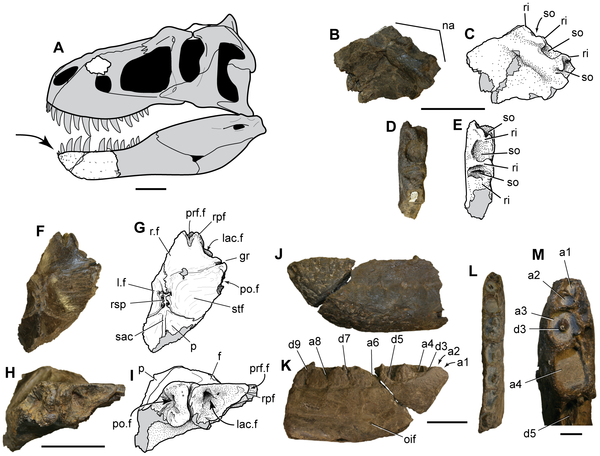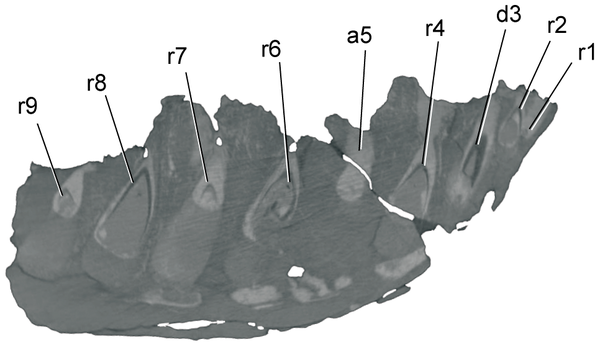Tyrannosaurid theropods were dominant terrestrial predators in Asia and western North America during the last of the Cretaceous. The known diversity of the group has dramatically increased in recent years with new finds, but overall understanding of tyrannosaurid ecology and evolution is based almost entirely on fossils from latitudes at or below southern Canada and central Asia. Remains of a new, relatively small tyrannosaurine were recovered from the earliest Late Maastrichtian (70-69Ma) of the Prince Creek Formation on Alaska’s North Slope. Cladistic analyses show the material represents a new tyrannosaurine species closely related to the highly derived Tarbosaurus+Tyrannosaurus clade. The new taxon inhabited a seasonally extreme high-latitude continental environment on the northernmost edge of Cretaceous North America. The discovery of the new form provides new insights into tyrannosaurid adaptability, and evolution in an ancient greenhouse Arctic.
![: Relative size of Nanuqsaurus hoglundi. Silhouettes showing approximate sizes of representative theropods. A, Nanuqsaurus hoglundi, based on holotype, DMNH 21461. B, Tyrannosaurus rex, based on FMNH PR2081. C, Tyrannosaurus rex, based on AMNH 5027. D, Daspletosaurus torosus, based on FMNH PR308; E, Albertosaurus sarcophagus, based on TMP 81.10.1; F, Troodon formosus, lower latitude individual based on multiple sources and size estimates; G, Troodon sp., North Slope individual based on extrapolation from measurements of multiple dental specimens [47]. Scale bar equals 1 m. doi:10.1371/journal.pone.0091287.g008](http://worldfossilsociety.org/wp-content/uploads/2014/03/131029133124-large-1024x342.png)
: Relative size of Nanuqsaurus hoglundi.
Silhouettes showing approximate sizes of representative theropods. A, Nanuqsaurus hoglundi, based on holotype, DMNH 21461. B, Tyrannosaurus rex, based on FMNH PR2081. C, Tyrannosaurus rex, based on AMNH 5027. D, Daspletosaurus torosus, based on FMNH PR308; E, Albertosaurus sarcophagus, based on TMP 81.10.1; F, Troodon formosus, lower latitude individual based on multiple sources and size estimates; G, Troodon sp., North Slope individual based on extrapolation from measurements of multiple dental specimens [47]. Scale bar equals 1 m.
doi:10.1371/journal.pone.0091287.g008

Nanuqsaurus hoglundi, holotype, DMNH 21461. A
. Reconstruction of a generalized tyrannosaurine skull, with preserved elements of holotype shown in white. Arrow points to autapomorphic, reduced, first two dentary teeth. B–E. Photographs and interpretive line drawings of right maxilla piece in medial (B, C); and dorsal (D, E) views. F–I. Photographs and interpretive line drawings of partial skull roof in dorsal (F, G); and rostrolateral (H, I) views. J–M, partial left dentary in lateral (J); medial (K); dorsal (L) views; and close-up of mesial alveoli in dorsal (M) views. Abbreviations: a, alveolus, with number indicating position in tooth row; d, dentary tooth, with number indicating position in tooth row; f, frontal; gr, orbital groove; lac.f, lacrimal facet of frontal; l.f, left frontal; na, nasal contact surface; oif, oral intramandibular foramen; p, parietal; po.f, postorbital facet of frontal; prf.f, prefrontal facet of frontal;. r.f, right frontal; ri, ridge separating sockets in nasal articulation of maxilla; rpf, rostral process of frontal between prefrontal and lacrimal facets; rsp, rostral spur of parietal; sac, sagittal crest; so, socket for nasal articulation of maxilla; stf; supratemporal fossa. Gray fill indicates missing bone or broken bone surfaces and cracks. Scale bar in A equals 10 cm. Scale bars in B–L equal 5 cm. Scale bar in M equals 1 cm.
doi:10.1371/journal.pone.0091287.g003

Nanuqsaurus hoglundi, holotype DMNH 21461, CT slice through partial left dentary.
Parasagittal CT scan slice through the partial left dentary shows several replacement teeth remaining in alveoli. This slice shows parts of cross-sections through replacement teeth in the first and second alveoli, verifying their identity. Abbreviations: a, alveolus, with number indicating position in tooth row; d3, base of partially erupted third dentary tooth, r, replacement tooth (unerupted), with number indicating position in tooth row.
doi:10.1371/journal.pone.0091287.g005
Citation: Fiorillo AR, Tykoski RS (2014) A Diminutive New Tyrannosaur from the Top of the World. PLoS ONE 9(3): e91287. doi:10.1371/journal.pone.0091287 Editor: Peter Dodson, University of Pennsylvania, United States



 March 19th, 2014
March 19th, 2014  Riffin
Riffin  Posted in
Posted in  Tags:
Tags: 